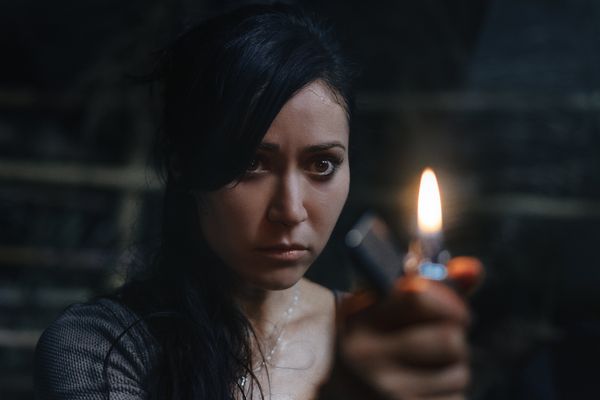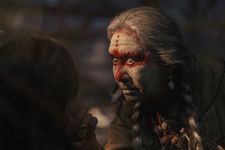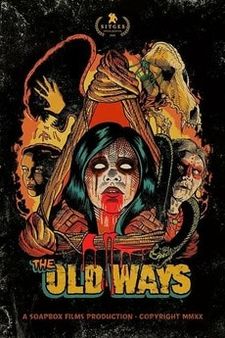 |
| Brigitte Kali Canales in The Old Ways Photo: courtesy of Glasgow Film Festival |
When a journalist who left Mexico as a child and has built her career in the US returns to the place of her birth in search of interesting cultural phenomena to write about, she gets more than she bargained for. This is The Old Ways, part of the Frightfest selection at this year’s Glasgow Film Festival. It’s a story about identity, demonic possession and ancient rituals. A few weeks before the festival, I met up with director Christopher Alender, writer Marcos Gabriel and star Brigitte Kali Canales to discuss the development process, the shoot and more.
“Marcos and I have been working together since we were teenagers in the Nineties,” says Chris. “He came up with the idea for this. We were trying to find something we could do that would be kind of contained and something that we could control and get off the ground, you know, without spending years and years and years trying to make it happen. Because we've been through that for a while now. And he came up with this concept. He wrote, maybe like 30 pages of it. Something like that.” He nods to Marcos. “You can take over from here.”
“Yeah, I wrote the first 30 pages,” says Marcos. “We were shooting a different movie on our soundstage and we were using the space really well. Yeah, it was like, ‘Can we do this? I think this will be a good thing to do.’ So while the movie was shooting with a different team, I wrote the first 30 pages and I showed it to Chris and I said ‘Is there anything here? Like, does this feel like a movie?’ And Chris, luckily, was like, ‘Yeah, that sounds really cool. Let's keep going.’
“So I finished writing the draft and revised it a bunch of times until it felt like ‘Oh, gosh, this feels like it's real.’ And we were trying to take every opportunity we had to not be conventional, so we really kept looking at the script over and over again and going like, ‘If another movie would do this, let's find our different way of doing it or let's not do it at all.’ So there's no priest saying ‘The power of Christ compels you.’ There's no upside down crosses or pentagrams because that's not are kind of exorcism story we're telling in the culture that we're exploring. So that was really thrilling.
“Then the script just kept evolving throughout it. So I would write and rewrite the script and Chris and I would talk about it as he was shooting and go like, ‘Hey, by the way, now I can see in the other room, so this scene doesn't make sense,’ or ‘Is there another opportunity now that this is like this? Okay, let's rewrite that.’ Same thing, as Chris would do research. He found the death whistle in his research, and he was like, ‘This thing's awesome. We have to figure out how to use it.’ ‘Okay, great. We'll make it. We'll add that into the script. And we'll do it all organically.’ And really, that was the most fun part about it.
 |
| Brigitte Kali Canales and Julia Vera in The Old Ways Photo: courtesy of Glasgow Film Festival |
“It was really a conversation with all our talented people that we're working with, to really maximise what they could do, because we're on a very limited budget. But instead of pushing things in the wrong direction, just because of what it says on our paper, we would try to go, ‘Okay, well, what is the thing we can do? And what is the most effective way to do it?’ And then, beyond all that stuff, the movie came about because I love horror movies. So it's really just a culmination of all this stuff that we wanted to do.”
Brigitte came on board with a lot less opportunity to prepare.
“Oh, God, it was all so fast,” she says. “It was a very quick turnaround. I think within a week, it all happened. First of all I got a 14 page audition. I'll never forget. And I said, ‘What the hell?’ Because you know, you usually get like five pages, that's probably like the norm. Maybe like, eight. This is pushing it. But I never get 14 pages. So it was very quick. I think I had like one full day to work on it and then I had to go into the room. And so I was just overwhelmed with the dialogue. But it was written well, so I was able to memorise it quickly. And then I just said, ‘You know what, I have no idea what's going to happen, I'm just going to go for it.’ Because it's 14 pages and Lord knows, one day is not enough.
“So I just kind of went with it and did my best and, and I remember at the callback, the assistant said, ‘Oh, Bridget, there's two more pages.’ So literally two minutes later, you know what I did? I said ‘Let's do it.’”
Did that give her an idea of the kind of things that they were going to put her through on set, and what her character was going to have to deal with?
“I felt like it was a good match. And I felt good in the room. It felt like there was a chemistry between all of us. But you never envision what's really going to happen from paper to actually being there. You can't imagine that, the magnitude of it, like, what a big difference it is from your brain to the actual happening. So yeah, definitely. But it was different once we were there.”
There are some distinctly unpleasant things that her character has to go through, from being force fed milk to having to pull things out of her mouth.
“I read it and I said, ‘Okay, here we go,’ she says, explaining that when they actually got there, Chris wanted to find an approach that would be less hard on her.
“I was like, ‘No, this is hard. This is for real. I need to feel it.’ There were different instances, like I really wanted to be tied down. It just made me feel more real, you know? I feel like we're always searching for truth in our work, so that made me feel closer to the actual true emotion and what I would really feel in that situation.”
Did she feel that that what she played was directly what was on the page or that she had a lot of input?
“I think it ended up becoming a fusion. I mean, Chris and Marcos, they were so open to collaborating and anything I said they really were taking into account, I felt like it it ended up becoming like a fusion of our creativity. If I felt like I was unsure, I would always tell Chris, ‘Chris, keep an eye on me.’ I would just check in with him on everything.
“There was like one scene where we didn't feel like my immediate interpretation was on it. And so we worked it with me a few times. And I remember that one was probably one of my most frustrating moments, because whenever you feel like you don't nail something, you feel a bit alone, you know? You feel like, ‘Am I doing this right?’ But Chris was great about making me feel like we're just exploring and we're going to figure this out. He was very supportive. So yeah, I definitely think it was a creative process. And I think that I got thrown into so quickly that I didn't have enough time to really sit with the material, but once we were on set, everyone was so respectful and cooperative, and that allowed for us to be able to build that character.”
 |
| The Old Ways poster |
One challenge that they faced on set was shooting in a very small space. I ask Chris how he dealt with that and he explains that originally they thought they were going to have even less room to work in.
“We didn't know how much money we'd have to spend or how much time or whatever when we were writing it,” he says. “So we were actually intending to reuse the same room and redress it. And that was going to make it feel a lot more claustrophobic, I think. And then as we started talking to our production designer [Bryce Perrin], he had some ideas for building the entire compound as one standing set, so we had the same amount of walls as one room, but he made all these kind of floating walls. Like, you know, a wall made out of bamboo, and then areas where it just went to black and there was kind of set dressing in front of it. It really enabled us to explore the space and see further, you know, much further. Even though it's a small 12 by 12 or 14 by 14 room that she was in for a lot of the movie, you could see 20, 30 or 40 feet back and get hints of what might be there or what people might be doing. Or you can hear goats and chickens and all that kind of stuff.
“We had the advantage of building that set before we even cast. So me and cinematographer [Adam Lee] had a lot of time with the stunt coordinator [Mallory Thompson] to explore the real space. And we were able to film a lot of the movie, on our iPads, on video and stuff, and really explore it like a real place. We wanted to feel like we were on location. Try to like, force ourselves to do things the way we have to do it on location where we wouldn't just get rid of a wall and put the camera in a corner. We tried to really make it feel lived in and not like we were watching a stage, I guess.”
There are a lot of things in the shadows and parts of it and things that we don't quite see, I note. What was it like for Brigitte acting against that kind of thing?
“It’s just imagination, using your imagination,” Brigitte says. “It really took the challenge to the next level. But Chris was great about giving me eyelines. And you know, the rest is kind of my job to lead. So I just wanted it to feel real. And obviously that’s easier when you have something there to look at. I always like to have something placed there so my eyes can see something. But sometimes you don't have that luxury. Chris gave me something to at least look at. And then I had no idea what the creature was actually going to look like. It was fascinating to see what it ended up looking like.”
“Horrifying,” says Marcos, and she agrees.
A lot of people are nervous about working with that kind of material and doing so much work focused around imagination, because it can take a really long time if things go wrong. How much time did they have onset and how much room did they have to experiment?
“We we felt like Chris gave it enough time,” says Brigitte. “The days that the demon was there, it was like, the focus was really on the demon. You know, we honoured it while we were on set just because we knew the mechanics of it was going to be difficult and finding the where to look. Sometimes I had to look, I couldn't look in the demon space. I had to look at the demon’s armpit, you know? All those little things that you figure out as you're working.”
Were there any unexpected challenges?
“I think the most challenging part for me personally was the day that I was tied down,” says Brigitte. “It was so damn cold in the building, and we were not expecting it to be that cold. That was the only moment I really felt overwhelmed because I knew for the scene and for the experience of the audience and for the character it needed to happen that way. I was freezing. And I remember, I didn't want them to untie me, I was kind of fighting myself. I was just like, ‘I don't want them to untie me because I know this needs to happen in order for this to feel real. I need to stay here even if I’m freezing.’ And Chris was like, ‘Are you sure you don't want to break?’ And you know, I'm like, ‘Yes, I want to break. No, I need to stay here.’ I felt so emotional, like I was on a roller coaster that day.“
“There was also the incredibly uncomfortable contact lens,” Chris recalls
“Oh my gosh, how can I forget?” Brigitte exclaims. ‘Oh, my God, that lens was so thick. I mean, I don't even know, how thick was it? I don’t think anyone should ever have anything over a millimetre. That felt like two inches. It just felt so wrong for it to be in my eye. And that was hard. So weird.”
Like many filmmakers I’ve spoken to lately, they’re disappointed not to be able to tour with the film and visit festivals in person, but still very positive about it screening in the Glasgow line-up. In part two of our conversation – coming soon – we discussed festivals, as well as reflecting on some of the themes in the film.
The Old Ways will be available to watch at the Glasgow Film Festival for 72 hours from 18:30 on the 5th of March.





















